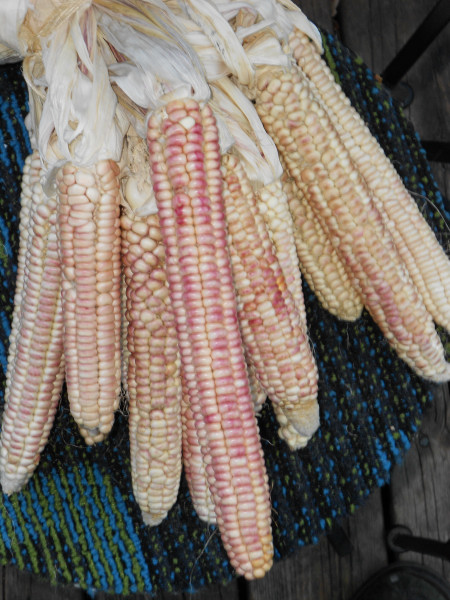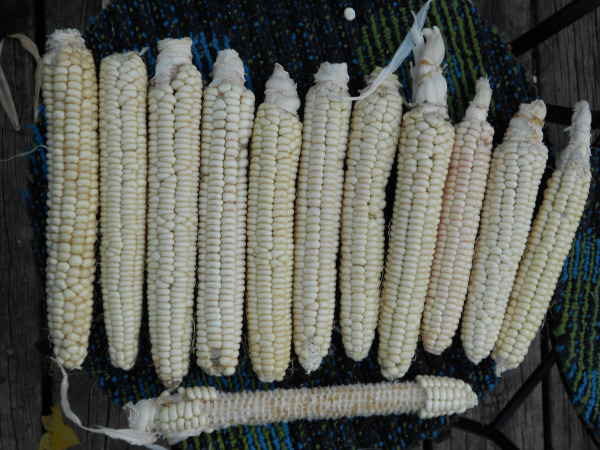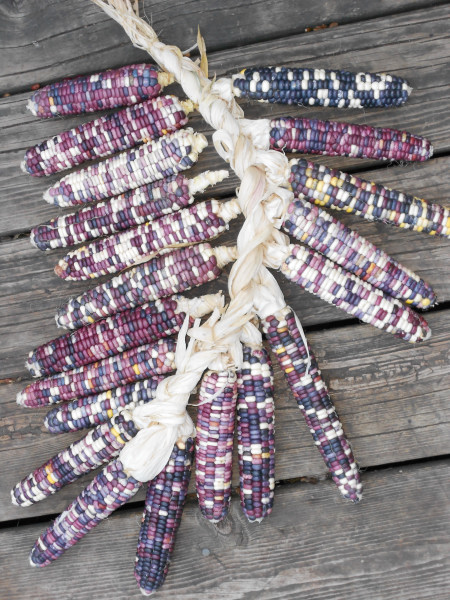
Shown above is Mandan Pink Flour. It comes from Mandan White Flour which comes from Mandan White Flint.
It all comes from this: about 8 years ago I read Buffalo Bird Woman’s Garden (which you can read for free on Google Books if you find the original publication and not a current reprint copy) where she mentioned that they believed that all their corn came from White Flint. She was a Hidatsa, but their tribe and the Mandans had combined back when they were devastated by smallpox. Eventually the Arikara joined up with them as well for the same reason.
I grew Mandan White Flint a few years in a row as isolated as I possibly could. Every year it would give me a few hundred flour kernels total out of all the cobs. I saved every one I found. When I had about 4oo I purchased Arikara White Flour corn seeds from Glenn Drowns. I planted 10 rows of corn, and the middle 4 were the white flour corn seeds from the Mandan Flint. They all tasseled and matured around the same time. I saved the best ears and planted. They still showed white. Some ears showed flints, but not whole ears, and I did not save those seeds.
When I planted it last year, I ended up with two plants that each gave me a pink cob. Both nicely formed, and the pink was just on the caps of the seeds. Finding it interesting, I planted 2 rows from the pink seeds flanked by rows from the white seeds. This year I got 15 ears that were well formed (though not uniform) so now I have about two pounds of center cob seeds to grow next year, or whenever I get around to it.
The Mandan/Hidatsa/Arikara tribes did not grow any of their corn in isolation. They grew it separated by distance; usually about 20 feet, with squash or beans grown between. They knew that the corn would cross, and they called it “walking” but simply saved by type (color, texture, etc) as they wished, so they were crossing things all the time, which is likely why they did not have the issues with corn inbreeding as many who try to keep old lines pure do.

This is what I mean by center cob seeds (the White Flour shown) being that I do not save the tip or butt seeds for replanting. They just go into the eating selection bags (which is all the corn that is not insect damaged) which will get ground up as needed for corn flour.

I finally shelled out all of my Wamneheza today too. The braided skeins were nice, but just in the interest of space, and how small our house is, I wanted to get it done. All that is left is the Victor Kucyk 2175 which is still out on the deck. Going to give that one some more time in the sun before I strip it down.
Palms got a little red from shelling by hand, but no where near as bad as the first year I did this. If you try this, and it is your first time, expect to likely develop some callouses unless you are a bricklayer or something along that line. Or if you spend a lot of time walking around on your hands. That would do it too.


Beautiful! Thanks for the description of your selection method. This was a VERY tough year for corn, here in NE Oklahoma. We harvested very little, though Mesquakie Indian did show some real spunk.
I planted about 800 plants of that at my Red Wing garden. I assume it is gone to wildlife of swallowed by weeds. Oh well. Each year is a different adventure. Not getting the fence up, then the accident kind of meant that one had to be abandoned since it is over 90 miles away and I have no way to logically tend it until I am healed up.